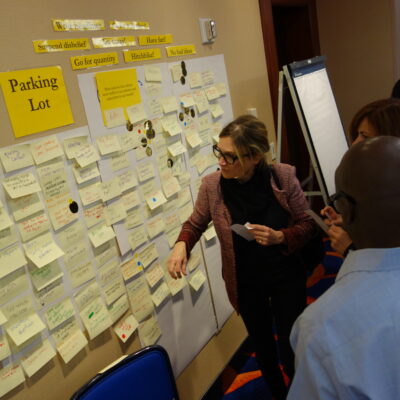Employers traditionally looks for brand new employees when hiring – but what if there’s an easier and cheaper option? Choosing internal employees for new positions promote loyalty, boosts employee confidence, and saves your company money in the long run. In fact, employees who have moved internally have a 19% higher chance of staying with an organization than those who don’t according to LinkedIn. Though that is a huge benefit, it’s only the beginning of what internal mobility has to offer.
Promoting mobility internally has numerous benefits. It can improve retention rates, morale, and engagement. On top of that, it can reduce costs for recruitment and training, making it a must-have tool for businesses.
What is Internal Mobility?
First, we need to answer the main question—what is internal mobility? At its core, it is simply the ability for employees to move within a company, whether vertically or horizontally. This includes things like internal hiring, mentorships, job swaps, shadowing, cross-team projects, and more.
So why do you need it? Employees want to feel like there is room to grow and move, and mobility offers that. It can help them develop their skills, gain new knowledge, and grow as professionals.
When that need is met, employees are much more engaged and likely to stay at the company and become great leaders. Overall, it’s a huge benefit for employees and businesses.
What are the Benefits of Career Mobility?
Now that the what and why are covered, let’s look a bit closer at a few of the main benefits.
Talent Retention
Offering a sense of mobility helps boost talent retention. As the stat mentioned above shows, employees are more likely to stay with a company where there are opportunities to learn new skills.
And that makes sense; employees don’t want to feel trapped, and they’re going to stay in an organization where they feel there is room to grow.
Cost Savings
Another benefit is cost savings. Recruiting, hiring, and training all take time and money. Over time, those costs can quickly add up. And while that may be worth it sometimes, you can save a lot of money by hiring internally.
A current employee doesn’t need nearly as much training or onboarding as a brand new employee, and there are no recruitment costs. Though it may not seem like much, this money saved can be used for more productive purposes.
Enhanced Engagement
Career mobility can also enhance engagement. Employees want to have meaningful work, and a sense of mobility can make that work more meaningful by providing incentives.
It increases engagement via morale as well. Employees have increased morale when they feel there is something to work towards, which directly leads to higher engagement and productivity.
Better Leadership
Internal mobility can increase leadership on top of all the other benefits. Employees who have been with a company for a while tend to be more effective leaders since they have a good understanding of the company, their coworkers, etc.
Leaders who are promoted internally have also typically climbed every wrung to get their as well, so they have a large amount of knowledge about the company and have earned the respect of other employees and understand those at the lower end of the totem pole more deeply.
Continuous Learning
Lastly, offering mobility internally promotes continuous learning. Employees are learning new skills, trying new positions, and pushing their limits. All of this results in stronger, more well-rounded employees.
This also helps boost internal innovation, which can help a company stay competitive and get a leg up on competitors.

Four Types of Internal Mobility
Before we dive into the best practices, it’s important to cover the four types of internal career mobility.
Role-to-Role Mobility
First up is role-to-role mobility, which is essentially moving horizontally. Employees transition into a new role, but they remain at the same level of seniority and salary range. While that may seem pointless to some, it has plenty of benefits.
Horizontal movements can help employees develop their skills, learn more about the company, form more bonds with co-workers, and find the positions that are the best fit for them.
Upward Mobility
Upward mobility is what people typically think of when this topic comes up. This is promoting within—employees being promoted from within the organization to a more senior title, typically with a raise in pay.
This saves money on recruiting and onboarding, gives employees opportunities for growth, increases retention, boosts morale, and more – all of which can help propel your business towards success.
Project-Based Mobility
This type of mobility involves partially or temporarily moving within an organization for specific projects. For example, you might have a member of the sales team work with the marketing team for a project.
Though this form of mobility isn’t permanent, it still has benefits. Employees can learn new skills, develop and deepen bonds, gain a better understanding of other departments, and try out a new position.
Location Transfer
Likely the least common, location transfer is another form of internal mobility. As the name implies, this is a job change that comes with a change in location.
This type of mobility can give employees an increased sense of freedom. If they want to move and try working and living in another location, the option is there.
On top of that, it can benefit the employee and the organization. The employee who is moving can gain a new perspective while bringing their ideas into a new office.
Internal Career Mobility Best Practices
To help you create an effective internal mobility strategy, here is a list of the key best practices for mobility within an organization.
Hire Supportive Leadership
It should be no surprise that supportive leadership is essential to promoting mobility internally. Strong and supportive leaders can encourage movement, help employees through it, and provide them with the necessary support.
Consider using team building programs like Leadership Stories and Leadership DNA to improve leadership. These events can develop, foster, and improve leadership, making your organization better as a whole. With strong leadership, providing mobility internally is much easier. These leaders can make good decisions about promotions and movements, guide employees through the changes, and ensure that everything goes well.
Foster Career Development Programs
Another best practice is to foster career development programs. If you want employees to move up within an organization, you need to help them grow as people and professionals so they are ready to take new positions and move around internally.
Employee development programs and professional development workshops are great ways to bolster employees’ skills, strengthen bonds, and prepare employees for potential movements in the future. At the end of the day, career development helps employees grow—which makes them better employees for the business. They will have stronger and more varied skill sets and become more flexible, productive employees.
Ensure Transparent Communication & Policies
As with nearly everything in the workplace, transparent communication and policies are key. While mobility offers many benefits, it can also create drama and toxicity in the workplace without clear communication and policies.
Talk to employees regularly and take their input to heart. Make sure you communicate clearly about potential moves, promotions, and more. And be sure to have consistent policies around promotions and job changes to prevent misunderstandings.
Make Succession Planning a Priority
Succession planning is a key component of any internal mobility program. If you want to effectively move employees into new positions, especially higher ones, you need to have a plan. Essentially, don’t wait until the last minute to start figuring things out. If there’s an older employee you know is retiring next year, start looking for a replacement now. Identify candidates and work to improve their skills, that way you’re ready when the moment comes.
You don’t need to have a comprehensive multi-year plan for every employee, but be prepared. Know who is thinking about leaving or retiring, have employees you are preparing to take those roles, and be ready for succession.
Conduct Regular Performance Reviews
Another good idea is to conduct performance reviews. These can help you identify strengths and weaknesses, find areas in need of improvement, and prepare those employees for future job changes or promotions.
Performance reviews can serve as a personal benchmark, giving employees something to work towards while improving their abilities. They’re also a chance to identify employees for promotions or movements as well. You can gain a better understanding of where employees are, what they’re good at, and what positions they might be a good fit for.
Encourage Recognition & Rewards
Lastly, encourage recognition and rewards. Employee incentives are an incredible motivator, driving employees to do their best to get the praise they deserve. And of course, they’ll be strengthening their skills and improving their abilities while doing so, which will help them prepare for future promotions or job changes.
Boost Retention and Morale with Internal Mobility
Internal mobility is one of the most effective tools organizations have at their disposal. It can boost employee happiness, engagement, and productivity while saving money – making it an indispensable resource.
To do so however, you need to prepare your employees. TeamBonding is ready to help you facilitate career development events and get your employees ready for new jobs, opportunities, and positions.
Boost retention and morale by partnering with TeamBonding. We have a variety of events that are perfect for enabling mobility, so get in touch with us today.















